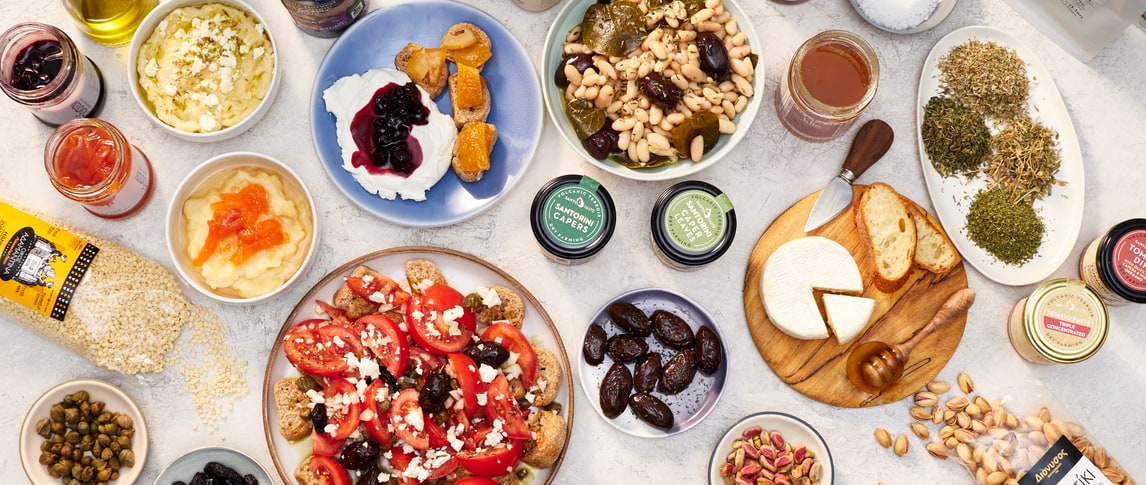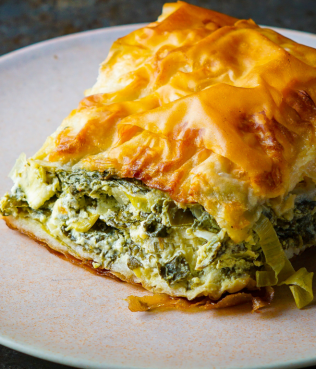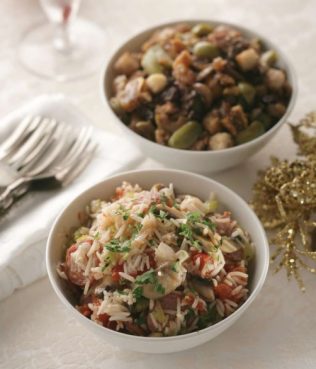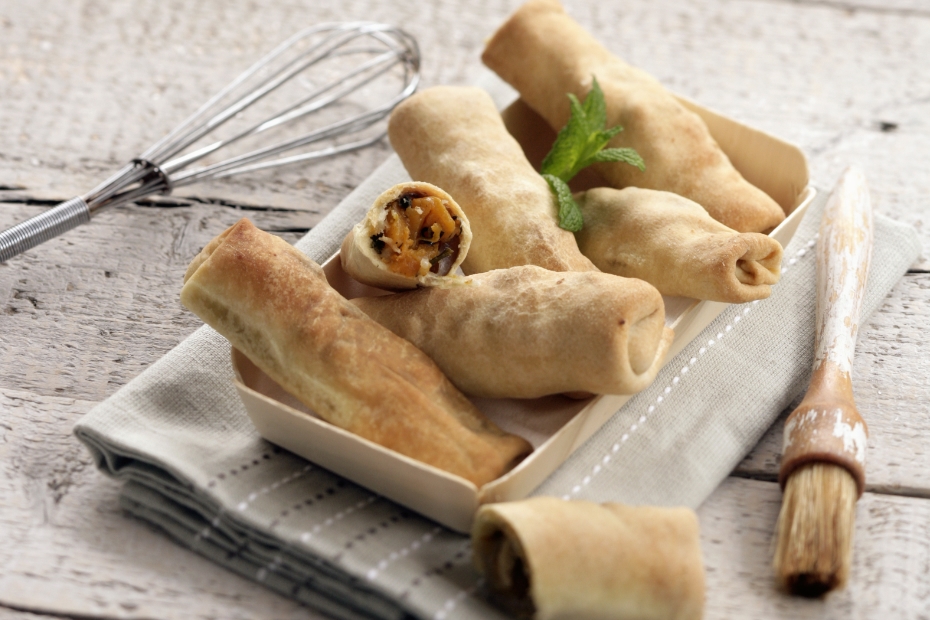 Traditional Greens and Pumpkin Pies from Ikaria (Pitarakia)
Traditional Greens and Pumpkin Pies from Ikaria (Pitarakia)
Ingredients (for 50 yields)
For the dough:
4 1/2 cups flour
1 scant tsp salt
4 tbsp olive oil
1 tbsp vinegar
300 gr. water
For the filling:
1 pumpkin, about 1 ½ kg, peeled and diced
4 onions, chopped
½ cup olive oil
1 bunch of fennel, chopped
1 bunch of mint, chopped
1 cup of fresh oregano, chopped
Salt and pepper
Prepare the dough:
1. In a bowl or mixer bowl, combine the flour with the salt. Then, add the oil, the vinegar, and the water. Mix until the ingredients are very well combined.
2. Knead the dough for about 10 minutes, adding flour or water until the dough is smooth and not sticky. Cover the bowl with plastic wrap and set aside for at least one hour before using it.
Prepare the filling:
1. Preheat the oven to 180°C.
2. Place the pumpkin in a shallow baking pan, lined with parchment paper. Bake for 20 – 25 minutes until softened and all liquids are absorbed.
3. Cook the onion in a large, heavy, dry saucepan, over low heat, for 8-10 minutes, without adding any oil, until it produces its own liquid and gets softened.
4. Add the oil and turn off the heat.
5. Transfer the pumpkin to the saucepan with the onion. Add salt, pepper and the herbs. Stir and set the mixture aside to cool.
Prepare the pies:
1. Divide the dough into 4-5 equal balls. Flatten a bit with the palms of your hands. Then, flour a working surface and roll them out to thin sheets.
2. Cut into squares, fill each square with about 1 tbsp filling, wrap the sheet so as to form oblong rolls, and place in oiled baking pan.
3. Bake in the oven for about 12-15 minutes or until golden colored.
Serve warm, at room temperature.
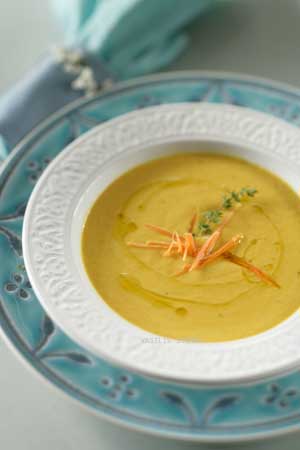
Carrot Soup with Ginger, Honey, Tahini, and Orange
Spicy Carrot Soup with Orange, Honey and Tahini
Serves 6
Carrot soup is an adopted Greek recipe. I sometimes make it with olive paste, too. In this recipe, with ginger, honey, oranges and tahini, the soup has an underlying texture and density that makes it perfect for a main course. Serve with a bit of good whole grain bread and a salad, and you don’t need much else to make a meal. Tahini is a great source of calcium and is used in many Greek Lenten dishes as a replacement for dairy.
Ingredients:
½ cup extra virgin Greek olive oil
1 leek, trimmed and chopped
1 onion, chopped
1 small fennel, trimmed and chopped
8 large carrots, peeled and diced large
1 clove garlic, finely chopped
1 small knob of ginger, about 1-inch / 2/5 cm big, peeled and finely chopped
1 tsp. ground cumin
½ tsp. ground turmeric
½ tsp. ground coriander
Pinch of cinnamon
Generous pinch of cayenne
3 sprigs thyme, leaves only
Juice and zest of 1 orange
2 tsp. Greek honey
4 tbsp. tahini
Salt and pepper
Raw shredded carrot, lemon slice, a pinch of hot pepper flakes, and olive oil to garnish each serving
Instructions:
Place the olive oil, leek, onion, fennel, garlic, ginger, and carrots together in a large, heavy soup pot. Cover the lid and sweat the vegetables over low heat for about 8 – 10 minutes, checking and stirring occasionally so they don’t burn.
Add all the spices and thyme to the pot and stir together with the vegetables for a minute or so to release their flavors. Season with salt and pepper. Pour in the orange juice and 1 ½ quarts / liters of water, cover the pot, raise the heat, and bring to a boil. Reduce heat to low and simmer the soup for about 35 – 40 minutes, until the vegetables are very soft. Add the orange zest, honey and tahini and stir until dissolved.
Using an immersion blender or food processor, puree the soup until smooth. Place back in the pot, add water if necessary if it’s too thick, taste for salt and spices and add accordingly.
Serve the soup hot, garnished with a drizzling of olive oil, grated raw carrots, a pinch of hot pepper flakes and/or a small slice of lemon.
[divider] [/divider]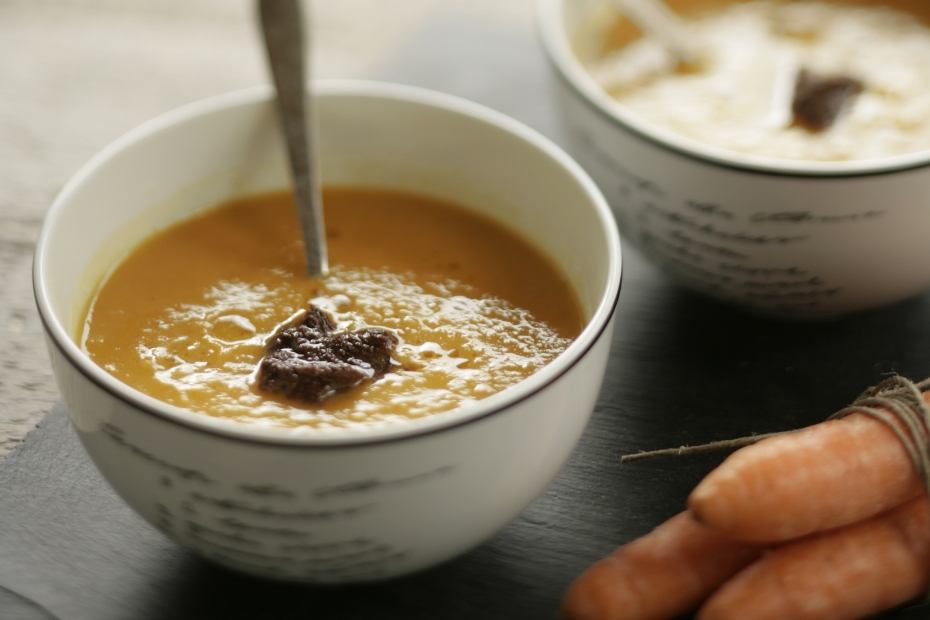
Serves 6
On a chilly Sunday in Athens, still worn out from a marathon of holiday cooking, and too spent to have gone to the supermarket with the Saturday crowds, I cooked with what was left in the fridge. That turned out to be a bunch of carrots, a little ginger, a dollop of the only Kalamata olive paste I’ve found that doesn’t numb your tongue with saltiness, and a Greek salad for the winter table, that came straight from a jar. The olive paste and the Greek salad are new discoveries; Peloponnese makes them. I found them at the Hellenic Gourmet Shop at the Athens airport. I do have a few other specialty foods that are always on hand, one of which is my all-time favorite vinegar, which is so good you can drink it. Vassilis Vaimakis makes it in Ioannina and you can find it at a few select gourmet shops in Athens, among them the Pantopoleion.
Ingredients:
10 carrots
1 one-inch knob of ginger
1 large red onion
2 garlic cloves
1/2 cup extra virgin Greek olive oil
1 heaping teaspoon turmeric
1 teaspoon cumin
6 – 8 cups water
1/3 cup rice
Salt to taste
2 – 3 tablespoons sweet Greek vinegar or good balsamic
A few drops of Habanero or Chipotle Tabasco (to taste)
6 teaspoons Kalamata olive paste, preferably from Peloponnese, because it isn’t too salty
Olive oil for garnish
One jar of Greek salad in a jar (I used Peloponnese, again because it was flavorful without being salty)
Pinch of dried Greek oregano
Instructions:
1. Peel and chop the carrots and ginger and chop the onions and garlic. Heat the olive oil in a large, wide pot and add the carrots, ginger, onions, and garlic. Cover the pot, keep the heat on low, and let the vegetables cook without water for a few minutes, steaming in their own moisture. Stir in the spices and toss all together for a minute.
2. Add the water to the pot. Add the rice. Season with salt. Cover, raise heat to bring the soup to a boil then lower it again, simmer for about 45 minutes, or until all the vegetables are extremely soft.
3. Use an immersion blender or empty the soup into the bowl of a food processor and process until very smooth. Return to the pot if using a food processor. Adjust the consistency with a little water and adjust the spices to taste. Reheat for a few minutes, and add enough vinegar to balance the soup. Stir in the hot sauce, if using.
4. Serve the soup in individual bowls, spooning in a little of the olive paste and drizzling in Greek extra virgin olive oil. Drain the Greek salad and place in a small bowl. Drizzle extra virgin olive oil and a little oregano over it, and Voila, lunch is ready.
[divider] [/divider]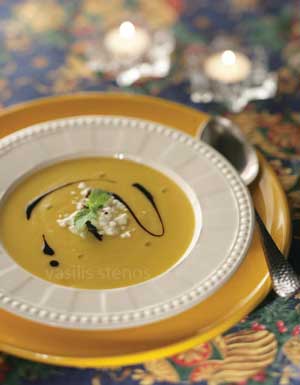
Add a touch of Greek yogurt and Greek honey to pumpkin soup
Pumpkin Soup with Greek Yogurt and Honey
Serves 8
I can’t get enough of pumpkins during the holiday season! The sweetness of this all-American vegetable goes amazingly well with Greek yogurt, Greek honey, Greek olive oil, and Greek kefi! There are a surprising number of pumpkin dishes, sweet and savory, in Greek cooking.
Ingredients:
2 pounds/1 k pumpkin
Salt and pepper to taste
4-5 fresh sage leaves or 1-2 sprigs of dried Greek sage tea (faskomilo)
2 tbsp. Greek extra virgin olive oil
2 leeks, white parts only, chopped
1 large carrot, finely chopped or thinly sliced
3 shallots, chopped
2 large onions, chopped
6 cloves garlic, melted
3 tbsp. Greek thyme or pine honey, or more to taste
8 cups vegetable broth
1 bouquet garni (bay leaf, thyme and parsley tied together)
4 tbsp. unsalted butter
1/2 cup strained Greek yogurt
Ground nutmeg
For the garnish:
½ cup. crumbled feta cheese
Balsamic Syrup for garnish
Olive oil for garnish
Mint leaves for garnish
Instructions:
1. Preheat oven to 375 °F/180 ° C. Cut the pumpkin in half lengthwise and remove seeds. Season with salt and pepper, sprinkle with fresh or dried sage, and brush with oil. Place pumpkin in a nonstick baking pan and bake for about 50 minutes, until tender. Remove from oven, let it cool slightly, and remove the flesh with a large spoon. Coarsely chop the flesh.
2. In a large skillet, heat oil and saute the leek, carrot, onion and garlic until soft. Add the chopped pumpkin, salt and pepper. Pour in the honey and stir for 2 to 3 minutes. Add the broth and herbs and cook all together for 30 minutes.
3. Remove the herbs with a slotted spoon. Using an immersion blender, puree the soup until smooth. If you desire a very smooth soup, pass the liquid through a sieve or chinois then place back into the pot.
4. Reheat the pureed soup just before serving, and whisk in the butter and yogurt. Season to taste with additional salt, pepper and nutmeg.
To serve: ladle soup into bowls and drizzle with olive oil and balsamic syrup. Sprinkle with crumbled feta. Enjoy!
[divider] [/divider]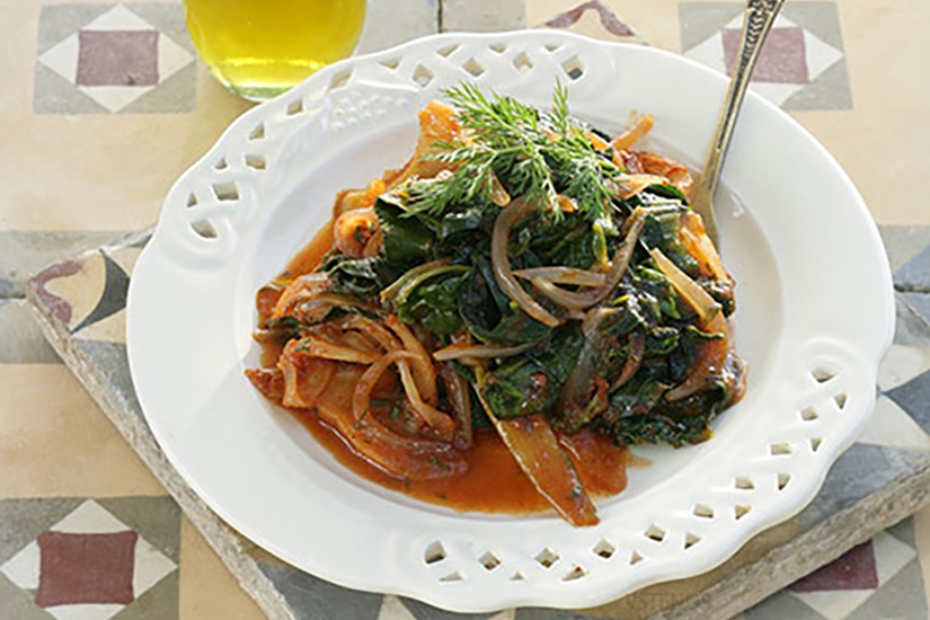
Serves 3
A simple winter recipe with sautéed wild greens from Corfu.
Ingredients:
2,5 pounds / 1 – 1 ¼ kg fresh, preferably mixed tender greens, such as spinach, sorrel and dandelion, trimmed and washed well
¼ cup extra virgin Greek olive oil
2 large onions halved and sliced
2 leeks washed well and finely chopped
1 ¼ cups snipped fresh wild fennel leaves or mint leaves
2 garlic cloves, minced
2 teaspoons sweet paprika powder
1 cup plum tomatoes, peeled and finely chopped
1 ¼ cups snipped fresh dill
Salt and freshly ground pepper to taste
1 teaspoon cayenne pepper
1 – 2 tablespoons tomato paste
Instructions:
1. Blanch the greens until wilted, and then drain completely.
2. Heat the olive oil in a large skillet and cook the onions and leek, stirring, over medium heat until soft, 5 to 7 minutes. Add the garlic, tomato paste, cayenne and paprika and stir for about 3 minutes. Add the wilted greens, dill, wild fennel leaves or mint leaves, and tomatoes. Simmer over low heat, uncovered, for about 20 minutes, until the greens are soft and all the pan liquids have cooked off. The dish should be fairly dry. Adjust the seasoning with salt and cayenne, and serve either hot or warm with fresh country bread. Pour a little fresh olive oil over the greens once they are cooked, if desired.
[divider] [/divider]Corfu Sweet Potato Bourdeto
Serves 4
Ingredients:
3 tablespoons Greek extra-virgin olive oil
2 large red onions, peeled, halved, and thinly sliced
2 garlic cloves finely minced
1 heaping tablespoon sweet paprika
1 teaspoon cayenne pepper, or more or less to taste
1 tablespoon tomato paste
3 pounds / 1,5 kg sweet potatoes, peeled and quartered lengthwise
1 cup dry white wine
Salt and freshly ground black pepper to taste
Instructions:
1. Heat the olive oil in a large, heavy skillet and sweat the onions and garlic over low heat, covered, until softened, 5 to 7 minutes. Add the paprika, cayenne, and tomato paste and stir with a wooden spoon for about a minute.
2. Add the sweet potatoes and stir for another minute. Pour in ½ cup of the wine and enough water to barely cover the potatoes. Bring to a gentle boil, lower the heat to medium-low, and simmer, covered, until the sauce is thick and dark, about 25 minutes. Season with salt and pepper.
3. Add the remaining ½ cup wine, cover the pot, and simmer until the potatoes are very tender, another 10 to 15 minutes.
4. Remove from the heat, let stand for about 5 minutes, and serve.
[divider] [/divider]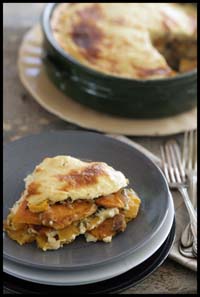
Pumpkin–Sweet Potato Moussaka
Pumpkin-Feta Pastitsio
This is a great dish for the holiday buffet. A large tray will feed up to 16 hungry revelers. The pastitsio isn’t traditional, of course. For one, there is no meat in this dish, but the savory tomato sauce filled with hearty chunks of sweet pumpkin more than makes up for that, as does the generous amount of cheese. It’s a tad time consuming, but each component can be prepared ahead, separately, and the pastitsio prepared the day before serving. You can even assemble it and freeze it, then defrost and bake as directed.
16 servings
For the Filling:
2 tbsp olive oil
2 tbsp butter
2 large onions, chopped
3 to 4 cloves garlic, chopped
Salt and pepper
2 ½ pounds pumpkin or butternut squash, peeled, seeded, and diced
1 / 3 cup. white wine
2 cups canned chopped tomatoes
1 cup chopped mint (leaves only)
For the sauce:
4 cups chopped canned tomato
1 cup white wine
1 cup water
2 tablespoons Greek honey
Salt and pepper
2 bay leaves
3 to 4 sprigs thyme
For cheese:
1 pound / 450 g feta cheese, crumbled
1 pound / 450 g fresh ricotta or Greek anthotyro, drained
3 eggs
Grating of fresh nutmeg
12 lasagna sheets sheets
1 ½ cups grated graviera, kefalograviera or other mild yellow sheep’s milk cheese
1. Make the filling: Heat oil and butter in a wide saucepan and add the onion and garlic. Sprinkle a pinch salt over the onions and garlic. Cook over low heat for about 8 minutes until softened. Add about ½ cup water and simmer uncovered until the onions are caramelized. Stir in the pumpkin and cook for five minutes, to soften a little and to release its flavors. Add the tomato, wine, water, salt, and pepper. Cook until there is no longer any liquid in the pot and the pumpkin is chunky but very soft. Stir in the mint. Remove from heat and cool.
2. Bring all the ingredients for the sauce to a boil in a medium saucepan, reduce heat and simmer until thick, about 20 minutes.
3. In a separate bowl, combine the cheeses, eggs and nutmeg. Add salt and pepper to taste.
4. Preheat oven to 400° F/200° C.
5. Drizzle the bottom of a medium size nonstick baking pan with 2 cups of the sauce. The pan should be large enough to hold 4 raw lasagna sheets in one layer. Place the 4 lasagna sheets over the sauce. Spread 1 / 3 of the pumpkin filling on top and then 1 / 3 of cheese. Repeat two more times ending with a layer of cheese. Pour the remaining tomato sauce over the top layer and sprinkle with the grated cheese. Bake for 1 hour, or until set. Remove, cool for 20 – 30 minutes, and serve.
Note: You can make the sauce and filling a day or two before actually assembling the pastitsio. You can also make the pumpkin mixture a week ahead, freeze, and defrost before using.
[divider] [/divider]
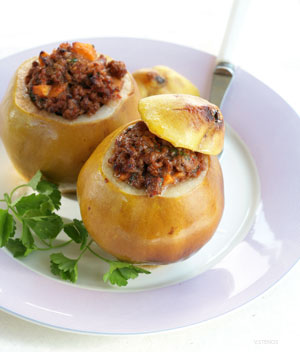
Serves 6
Ingredients:
6 large quinces
1 lemon, cut in half
6 tbsp unsalted butter or margarine
2 large onions, finely chopped
2/3 lb. / 350g boneless lamb meat, minced
1 large, firm, ripe grated tomato or 2/3 cup tinned tomatoes, pureed
Salt and freshly ground black pepper
1 tsp ground cinnamon
½ tsp ground cloves
½ cup finely chopped fresh parsley
1 cup water
Instructions:
1. Preheat the oven to 375F /190ο C. Cut the top of the quince fruits and set aside. Remove the pip with the tool used to seed apples, grate carefully and remove enough of the inside to leave a shell about 1 1/2 inches / 4cm thick. Rub the insides of the shell with lemon. Finely chop the quince pulp.
2. Melt 2 tbsp butter in a large frying pan on a low heat and add the onions. Cook, covered, until turn golden brown, approx. 15 minutes. Add the quince flesh and the lamb, raise heat to medium and cook until the meat browns lightly Add the tomato, salt, pepper, cinnamon and cloves. Simmer until all the liquid is absorbed. Remove from heat, let cool and mix in the parsley.
3. Spread some butter in each quince shell. Fill with the meat mixture shaping a small mound on top of each fruit. “Close” each quince with its top.
4. Place into an ovenproof buttered glass or clay dish. Melt the rest of the butter and pour it over the quince. Add the water, cover with foil and cook for 45-60 minutes. The quinces should be soft when poked with a fork and the filling fully cooked. Serve hot.
Notes
• Instead of tomato for the filling you can use 1/3 cup raisins and 3 tbsp baked pine seeds.
[divider] [/divider]
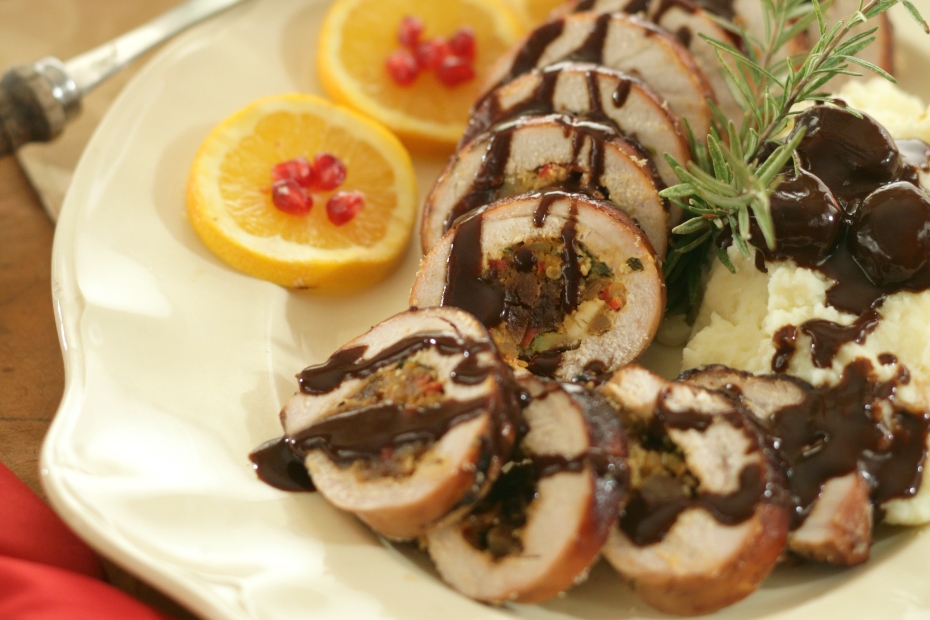
Turkey Roulade Greek-Style
Honey-Orange Glazed Turkey Roulade with Mavrodafni-Chestnut Gravy
Serves 6
An Easy Thanksgiving Turkey Dish, with Greek flair!
Ingredients
1 large turkey breast, boneless and skinless, about 2 ½ kilos/5 lbs., butterflied
1/2 cup Mavrodafni wine
1/2 cup coarsely chopped mixed dried fruits (figs, raisins, apricots, prunes etc)
1/3 cup Greek extra-virgin olive oil
1 cup diced celery
1 cup diced onion
1/2 cup diced roasted red Florina pepper
1 cup small, toasted bread cubes or croutons
1 cup crumbled feta or Kalathaki cheese
1 cup chicken stock
1 tablespoon dried thyme
1 tablespoon chopped Greek mountain tea (faskomilo)
1 tablespoon butter for rubbing
2 cups Mavrodafni for basting
Salt and pepper, to taste
For roasting pan:
1 orange, cut into rings
1 onion, coarsely chopped
2 celery stalks, coarsely chopped
For glaze:
2/3 cup Greek honey
3 tablespoons Greek or other mustard
Juice of 1/2 orange
For gravy:
1 cup Mavrodafni
1 cup dry red wine
4-5 thyme sprigs
10 peppercorns
2 bay leaves
15 chestnuts, boiled or roasted and peeled
Salt to taste
1 tablespoon butter
1 tablespoon flour
Orange slices and pomegranate seeds for garnish.
Instructions
Preheat oven to 375°F/180°C.
Rinse turkey and spread out on a cutting board. Pat dry and season inside and out with salt and pepper. Brush with 1 tablespoon olive oil.
In medium bowl, pour wine over dried fruits and let stand 15 minutes.
In heavy skillet, over medium heat, saute celery, onion and red pepper in 1 tablespoon olive oil for about 5 minutes, to soften.
Place bread cubes in large bowl and pour onion mixture over top. Add wine and fruits. Add stock, herbs and season with salt and pepper. Stir in crumbled feta or Kalathaki cheese. Mix thoroughly.
Spread the filling over the surface of the opened turkey breast and roll up. Using kitchen twine, or large metal skewers, secure the rolled turkey breast closed.
Rub outside of turkey with 1-2 tablespoons olive oil. Pour remaining olive oil in a roasting pan and sprinkle the onions, oranges, and celery in a line across the middle of the pan. Place the roulade on top. Pour in 1 cup Mavrodafni. Roast for about 30 minutes, until the turkey starts to color lightly. Pour in remaining wine, cover the pan with aluminum foil and roast for another 45 minutes, basting every 15 minutes or so and replenishing pan juices with additional wine, if necessary.
Make the glaze: Whisk together the honey, mustard and orange juice and brush this generously all over the surface of the roulade. Bake for another 15 minutes, until deep golden brown. Remove turkey from oven and from pan, and set aside covered with aluminum foil.
Make the gravy: Place pan with all its juices and burnt bits on the stove top and heat over medium flame, scraping up all the bits with a wooden spoon. Add the two wines, bay leaves, thyme, and peppercorns. Bring to a boil, reduce heat and simmer until the juices are reduced by half. Pour through a strainer into a measuring cup, let the fat rise to the top and skim it off with a spoon. Melt the butter in a small saucepan and stir in the flour. Brown it very lightly over medium-low flame. Pour in the reduced pan-juices and cook the gravy until thick, about 5 minutes. Stir in the chestnuts.
Cut roulade into thick rounds, garnish with orange slices and pomegranate seeds. Pour the gravy over the meat and serve, with mashed or roasted potatoes, if desired.
[divider] [/divider]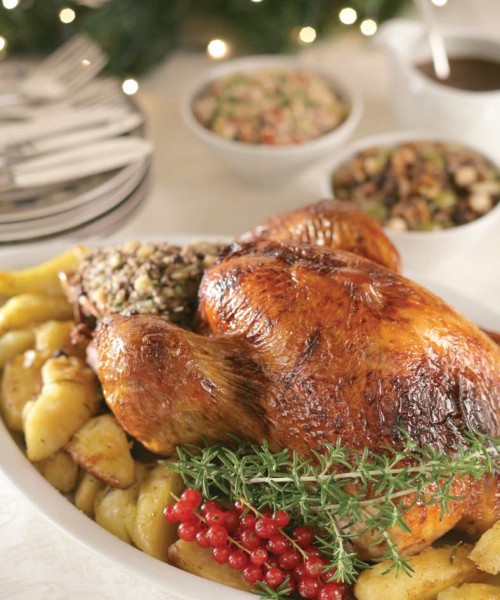
Classic Roasted Turkey
Thanksgiving Turkey with Greek Flavors
Turkey in Brine
Preparation
For Greeks, turkey, called gallopoula or “French bird,” is one of the two main options on the holiday table (the other is pork). Many Greek villagers raise their own turkeys, letting them roam free in gardens and yards all year round. No doubt, these free range gobblers are much tastier than the mass-produced birds with the thermometer pierced like a button inside their breasts. Free-range turkey is more muscular, has darker, gamier meat, narrower chests and bigger thighs than its commercially produced cousin. (If you are spending Thanksgiving in Greece try to find fresh turkey raised by the American Farm School in Thessaloniki).
Frozen birds need a little help to be made as palatable as possible. Older Greek cooks, my dad once among them, used to swath the bird with butter and strips of bacon and then swaddle it in cheese cloth. I have always found this to be way too much trouble.
Instead, for the last few years, I’ve either brined my turkey or simply basted it with near religious fervor, over the several hours of baking time it needs to roast properly. Greeks call brine, brine or almi. To brine a turkey place the bird in the solution below and leave it there for 24 hours. The salt acts as a conduit of sorts, breaking down the proteins and allowing the meat to absorb both the water and spices, which results in a tender, flavorful bird.
For a turkey of about 5-6 kilos (11-13 lbs)
8 ltr/8 quarts water
2 cup coarse salt
1 cup sugar
Juice of 1 large orange (also keep zest)
4 tbsp black pepper corns
4 bay leaves
15 fresh thyme sprigs
1 bunch parsley
1 cinnamon stick
6 cloves
20 allspice berries
4 pieces of star anise
2 tbsp mustard seeds
3 large onions, unpeeled and quartered
1 10cm/4-in. piece fresh root ginger, peeled and cut in slices
Find a basin or bucket large enough to hold the bird and the brine and small enough to fit in the fridge (or to keep in a safe place outside in the cold). Dissolve the salt and the sugar in 2 cups hot water. Add the 7 ltrs/7 quarts of remaining cold water and stir. Add the orange juice and zest and all the spices. Remove the giblets and neck. Submerge the turkey in the brine, cover with a weight and put in the fridge or outside if cold enough. Keep covered and let sit for 8-36 hours.
Cooking
When you are ready to cook the turkey remove from the brine and discard. Rinse the turkey very well with tap water and dry with kitchen paper. Tuck in the wings behind the back and place on a rack upside down.
From here onwards you can proceed with your favorite recipe but you must remember that the turkey has already absorbed a significant amount of salt, so the drippings you might use to make gravy will be salty enough, you should not add any more salt to the bird. Do add any other spices or herbs, as desired.
You don’t have to stuff the turkey. An unstuffed turkey will take less time to roast (you may make the stuffing separately).
Proper roasting of a brined turkey:
An unstuffed brined turkey needs about 20 minutes per kilo (2.2lbs) to cook whereas a stuffed one needs 25 per kilo (2.2lbs).
To be absolutely sure that the turkey is fully cooked place a meat thermometer in the thickest part of its flesh. When the thermometer reaches 76°C (167°F) it means the bird is ready. When using a frozen, defrosted turkey with an integrated thermometer it will pop on its own when ready.
Classic Roasted Turkey
1 turkey (5-7 kilos/11-15lbs)
2 carrots
2 onions
3-4 garlic cloves
1 fennel bulb
3-6 tbsp butter (depending on the turkey’s size)
Salt and pepper
1. Wash the turkey. Remove the giblets, which are usually in a small bag in the cavity.
2. Peel the carrots and the onions and cut in large pieces. Peel the garlic. Cut the fennel bulb in large pieces. Stuff the turkey’s cavity with all the above (this is not a stuffing but will give taste to the turkey while it’s cooking). Tie the turkey’s legs with string from a butcher so they don’t fall apart while roasting. Switch the oven on to 160°C (320°F).
3. Place the turkey on a rack which will fit in a large dish. This way the juices will fall in the dish and the turkey will not swim in its own fat while cooking.
4. Melt the butter in a small dish and smear it on the turkey. Place it in the oven and smear with extra butter and some of its juices every half hour. Half way through cooking begin the glazing using the desired glaze.
Glazing
Independently of whether you choose to prepare your turkey in brine or even stuff it, all turkeys should be glazed while roasting. The glaze is delicious if made with something naturally sweet, such as honey, grape must or pomegranate syrup. I like to give my glaze a Greek touch….Here are a few ideas:
Honey Glaze
½ cup Greek thyme or pine honey
¾ cup fresh, strained orange juice
2 tbsp grainy Dijon mustard
3 tbsp sweet Greek vinegar (there are various kinds, from currant or fig balsamic to an ancient recipe that’s been resuscitated, called oxymelo, literally “vinegar-honey”, you can also use a good quality balsamic)
1/2 cup melted butter, more if necessary
Whisk everything together and glaze the turkey in the last 1 ½ hours of roasting.
Pomegranate Glaze
¼ cup pomegranate syrup
¼ cup cranberry juice
½ tsp cayenne pepper
3 tbsp fresh, strained orange juice
½ cup melted butter
Whisk everything together and glaze the turkey in the last 1 ½ hours of roasting
Mavrodafni – Balsamic Syrup Glaze
1 cup Mavrodafni wine
3 tbsp balsamic syrup
½ cup melted butter
3 tbsp fresh, strained orange juice
Whisk everything together and glaze the turkey in the last 1 ½ hours of roasting.
For suggestions on Turkey Stuffing and Gravy check out this week’s Features and Favorites.
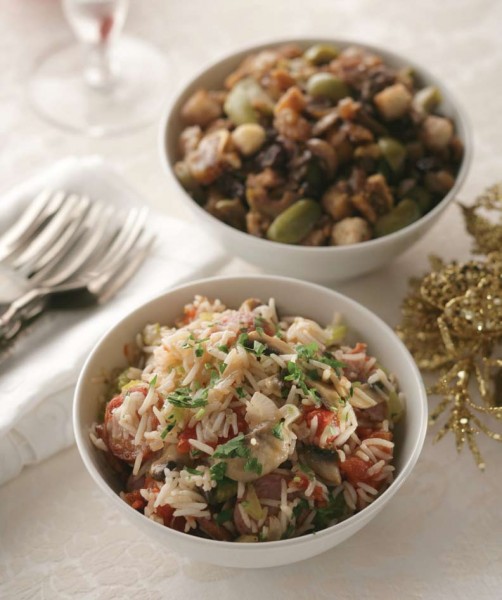
Two Turkey Stuffings
Greek Style Stuffings and Gravy
Turkey stuffing is one of those dishes that can either carry the weight of tradition or the freedom of experimentation. It all depends on one’s own personal preferences. I like both and sometimes make more than one stuffing as a result.
Every holiday, I sift through my recipe files to look for old favorites and new ideas. Images of sausages, plums, apricots, chestnuts, wild rice and more come dancing through my cook’s head.
I think my all-time favorite combines two Greek classics, olives and figs. They are great together, an irresistible contrast of textures and flavors that work in total harmony inside or outside the bird.
Another favorite is one that awakens childhood memories, the stuffing my mother used to make with ground meat, chestnuts, pine nuts and raisins. This is sometimes known as “politiki gemisi” or stuffing made the way the Greeks of Constantinople (Istanbul) always prepared it. My mom was half Ikarian and half Calabrese. Go figure…
All stuffings need a bit of starch to come together, usually bread (either dry or in crumbs) or rice. I prefer bread because I like the compact, soft, almost spongy texture that results when cooking dried or stale bread cubes together with all the other ingredients. It’s a very comforting texture. Rice can sometimes be problematic because it tends to turn into one soggy mass inside the bird.
A piece of advice concerning all stuffing: leave enough space for the stuffing to expand when adding it to the cavity of the turkey. To get the best “siglino”, figs, olives and honey for the recipes suggested go to TITAN FOODS if in the USA and To Pantopoleion tis Mesogeiakis Diatrofis if in Greece.
Stuffing Tips
Stuffing a turkey is easier than you think! The stuffing must always be at room temperature before you start. Stuff both sides of the turkey, cavity and neck. Tie the lower part of the turkey’s thighs in front of the cavity opening, with a piece of cottoncooking string, so it doesn’t fall apart while roasting or alternatively place half an orange or an apple in front of the opening. If you have left over stuffing cook it separately in a buttered ovenproof dish. It is very likely you might need a bit more stock.
To better control the color of the turkey while roasting, cover with buttered tin foil. Remove and replace when basting.
… with bread, olives and figs
For a turkey of 5-8 kilos (11-17lbs)
15 slices of whole wheat bread
6 tbsp butter
2 large onions, finely chopped
2 garlic cloves, finely chopped
½ cup dark raisins
3/4 cup finely chopped walnuts
1 cup coarsely chopped Greek pitted green olives
1 cup parsley, finely chopped
12 dried Greek (Kalamata or Kymi) figs, finely chopped
14 boiled chestnuts, peeled and chopped
Salt and pepper
½ – 1 cup chicken stock
1. Cut the bread into cubes and toast until dry in the oven or in a dry skillet. Saute the onion and garlic in 2 tbsp butter in a non-stick pan until soft.
2. Mix the rest of the ingredients excluding the stock and the rest of the melted butter. Stuff the turkey.
… with sausage and rice
For a turkey of 5 – 8 kilos (11-17lbs)
½ cup olive oil
1 ½ cup celery or Chinese celery, finely chopped
1 onion, finely chopped
2 garlic cloves, finely chopped
1 ½ cup chicken stock
1 ½ cup basmati rice
½ kilo (1.1lbs) sausage with orange or leeks (pork), cut in thin slices
125g (4.4oz) small fresh mushrooms, washed and cut in thin slices
1 tbsp mushroom powder
½ cup white wine
1 cup grated tomato
1 twig fresh sage, leaves only
Salt and pepper
Parsley to garnish
1. In a heavy non-stick pan heat 3 tbsp of olive oil and sauté the celery, onion and garlic over medium flame until soft for about 6-7 minutes.
2. Meanwhile heat the stock in a medium sized pan and when it boils add the rice. Boil until it absorbs all the stock but is still al dente.
3. In a separate frying pan, brown the sausage over medium heat. Remove the sausage pieces, drain off all but a tablespoon of the fat and sauté the mushrooms in that. Pour in the wine and cook for a few minutes, until the alcohol sizzles of and the liquid is reduced by half.
4. In a large mixing bowl, combine the rice, vegetable mixture, sausage, mushrooms, grated tomato, sage, salt and pepper. Let the mixture cool a little and stuff the turkey with it.
… with ground meat, chestnuts, raisins and pine nuts
For a 5 – 8 kilo (11-17lbs) turkey
3 tbsp butter
2 large onions, peeled and finely cut or ground in a mixer
2 celery stalks, cut in cubes
Turkey giblets, chopped (optional)
1 lb/500g minced beef
½ tsp cumin
1 pinch ground cloves
1 small cinnamon stick
Salt and freshly ground black pepper
½ cup dark raisins
1 cup cut almonds and pine nuts mixed
1 lb/500g chestnuts, cooked and shelled (sous vide are ok)
3 cups croutons
1. In a big, heavy, non-stick pan heat 3 tablespoons butter and saute the onion for 2-3 minutes until wilted. Add the celery, stir using a wooden spoon and continue sauteing until the celery and onions are soft, approx. 3-4 minutes.
2. Add the giblets (optional) and the ground meat and cook, stirring until lightly browned. Add ½ cup water, the spices, salt, and pepper and simmer uncovered over low heat for 3-4 minutes. Add the raisins, almonds, pine nuts and chestnuts and mix well. Continue simmering uncovered for 4-6 minutes until all liquids are absorbed.
3. Remove the dish from the heat and let the stuffing cool a little. Remove the cinnamon. Add the croutons and stir.
… with bread, Greek cured pork, prunes and cheese
For a turkey of about 5 – 8 kilos (11-17lbs)
12 pitted prunes
450g (15.8oz) bread, without crust
1/4 cup olive oil
4 tsp fresh thyme, chopped
1 large garlic clove, finely chopped
Salt and pepper
6 tbsp butter
1 ½ cup onion, finely chopped
1 ½ cup finely chopped celery
1 cup green pepper, finely chopped
1 ¼ cup chopped Greek cured pork (singlino) or other cured (smoked or salt-cured) pork (you may also use dried sausage)
1/3 cup fresh parsley, chopped
½ cup toasted walnuts, coarsely chopped
1 ¾ cup chicken or turkey stock, heated
200g (7oz) Greek goat’s cheese, such as kalathaki Limnou or tyrovolakia Lesvou, crumbled
1. Preheat the oven to 180°C (356°F).
2. Cut the bread into 2,5cm cubes (10 cups approx.). Place the cubes in a large bowl and toss with the oil, thyme and garlic. Bake the mixture on a shallow baking pan, tossing occasionally, until golden, about 15 – 20 minutes. Remove from oven, cool slightly and transfer back to the mixing bowl.
3. In a large, nonstick frying pan over medium heat, melt the butter and saute the onion, celery, and green pepper until wilted, about 6 minutes. Remove from heat, add the cured pork, parsley and prunes. Toss to combine. Add to the bread mixture. Pour in the stock and cheese and mix well. The mixture should be moist but not soggy. Stuff the turkey with the mixture and roast.
The gravy
Make the gravy after roasting the turkey. You will need:
Pan juices from roasted turkey
2 cups red wine
2 cups chicken stock (using stock cubes is fine)
2 bay leaves
3-4 thyme sprigs
Salt and pepper
1 tbsp corn starch mixed with 2 tbsp tepid water
Pour the pan juices into in a measuring cup. With a spoon, skim off the fat, which rises to the surface.
Place the roasting pan over two burners, heat on medium heat and add the red wine. Using a wooden spoon, scrape the bottom of the pan over the heat, to loosen the charred bits, which are delicious! When the wine is reduced by half, remove the pan from the heat and strain the liquid directly into a saucepan. Add the skimmed pan juices and the chicken stock. Add the bay leaves, the thyme and salt and pepper.
Simmer the gravy over medium heat and as soon as it comes to a boil whisk in the cornstarch mixture. Cook, stirring, until thick and velvety.
[divider] [/divider] [divider] [/divider]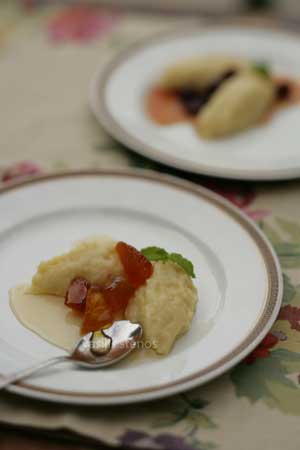
Sweet Greek Corn Cream with Pumpkin Preserves: Great for Thanksgiving! Image from my forthcoming book, The Country Cooking of Greece, Chronicle Books
Buttery Northern Greek Cornmeal Cream with Pumpkin Preserves
Serves 6
Are you starting to think about Thanksgiving? Here’s a really unusual, delicious recipe for sweet corn cream that comes from Northern Greece. The dish is adapted from my forthcoming book, The Country Cooking of Greece, Chronicle Books, pub. date: 2012.
Ingredients
4 cups water
½ teaspoon salt
1 cup finely ground yellow cornmeal
½ cup sugar
1 teaspoon finely grated orange or lemon zest
8 tablespoons butter (divided)
1 ½ cups pumpkin, eggplant, quince or orange spoon sweet* or any whole fruit preserved in syrup
Fresh mint leaves for garnish
Instructions
1. Bring the water and salt to a boil in a medium-size saucepan. As soon as it comes to a rolling boil, stir in the cornmeal in a slow, steady stream, mixing with a wire whisk as you go.
2. Add the sugar, orange zest, and half the butter. Stir continuously over low-to-medium heat until the sugar dissolves and the mixture starts to come away from the sides of the pan, about 40 minutes.
3. Let cool completely.
To serve
Either spread into a smooth circle or mound, or dip 2 tablespoons into the remaining melted butter and scoop out a heaping spoonful of the cornmeal, working it with the two spoons to shape like quenelles. Place 2-3 such mounds on each serving plate or spoon them all on a large, round platter.
Top with the preserves of your choice. Drizzle some of the syrup on top. Garnish with fresh mint leaves and serve immediately.
Notes: Spoon sweets are a staple in the Greek country pantry. They are basically preserves of either whole or chopped fruit, the rinds of citrus fruits, immature nuts and some young vegetables put up either in simple syrup or grape must molasses. They are available in Greek and Middle Eastern food stores all over the United States and Europe.
[divider] [/divider]
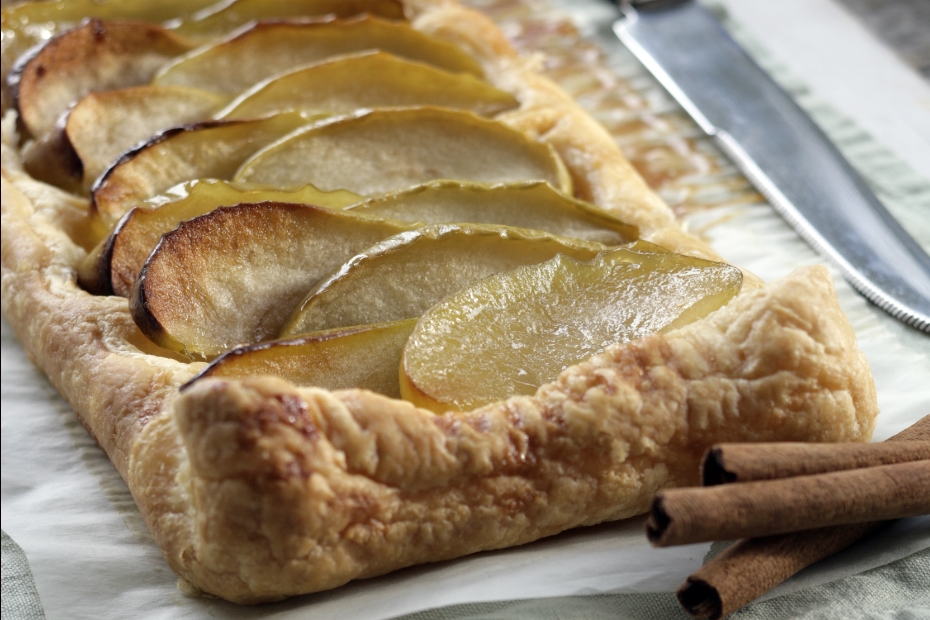
8 servings
1 sheet puff pastry ready (refrigerator), cut in half lengthwise
4 large green apples, with peel
2 tbsp. butter
¾ cup. sugar
2 tbsp cognac
1 cinnamon stick
2 rose geranium leaves (optional)
¾ cup. sugar
2 tbsp orange liqueur
2 to 3 tablespoons sugar for sprinkling
1. Preheat oven to 375°F / 180°C. Cut the puff pastry in half lengthwise and place the two rectangular pieces in a nonstick pan. Turn in the edges to make a decorative rim. Place the pan in the refrigerator until you are ready to bake the pies.
2. Quarter the apples lengthwise and remove seeds. Cut each quarter into thin slices. Heat butter in a nonstick skillet and sauté the apples with the sugar.
3. Once the sugar has melted, add the brandy, rose geranium and cinnamon stick. Cook the apples on medium-high heat for about 5-6 minutes, until they begin to brown slightly.
4. Remove the apples with a slotted spoon and cool. Next, place them in neat rows inside the chilled puff pastry rectangles.
5. Bake the tarts in preheated oven for approximately 18 to 22 minutes until they brown nicely and the apples are set. Remove, cool, and serve.
